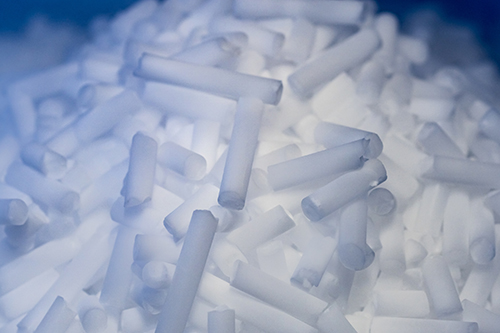A comparatively small but crucial piece of the massive rollout efforts designed to get the new Pfizer-BioNTech COVID-19 vaccine from the manufacturer into the arms of millions of recipients involves the storage and transportation of the precious cargo.
For UF Health, which began receiving the vaccine on Monday, this meant quickly acquiring specialized equipment to ensure the vaccine is stored and transported at optimal conditions.
One key piece is a machine that produces dry ice at the rate of 120 pounds each hour.
Dry ice, or solidified carbon dioxide, is commonly used as a cooling agent, as its temperature is exceedingly lower than water ice. Brad Pollitt, UF Health Shands Facilities vice president, said UF Health acquired the dry ice machine from the Florida Department of Emergency Management, which designated UF Health as one of a handful of locations across the state to store dry ice for regional transportation of the vaccine.
“The department had a number of machines to strategically place around the state so they could have access to dry ice in the future, he said. “This is so when we have to transport vaccines to Suwannee or Cedar Key or Chiefland, we will have dry ice to put in coolers.”
Michael Lauzardo, M.D., M.Sc., deputy director of the UF Emerging Pathogens Institute and a public health specialist who directs the UF Health Screen, Test & Protect initiative, said, “Maintaining the cold chain is going to be a critical need throughout the vaccination process. The state wanted to have partners in south, central and north Florida. University of Florida leadership wanted to support the state’s efforts in the vaccination process.
The Pfizer vaccine, which was the first sent to UF Health, must be stored at exceptionally cold temperatures — about minus-94 degrees Fahrenheit.
Along with the dry ice machine, UF Health had to acquire a another unique piece of equipment: a gigantic liquid carbon dioxide storage tank.
“One of the challenges was finding the tank itself,” Pollitt said. “We found a fairly large industrial tank, about the size of a semi trailer.”
Teams then ran pipes from the tank to the dry ice machine and provided the electrical service to the machines. Lastly, they had to order the carbon dioxide to fill the tank.
The new unit was operational as of Dec. 17.
This story originally appeared on UF Health.
Check out stories about UF research on COVID-19.

